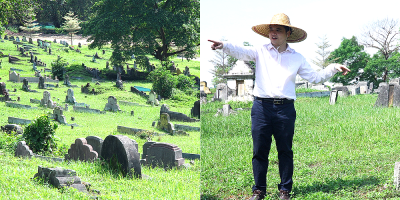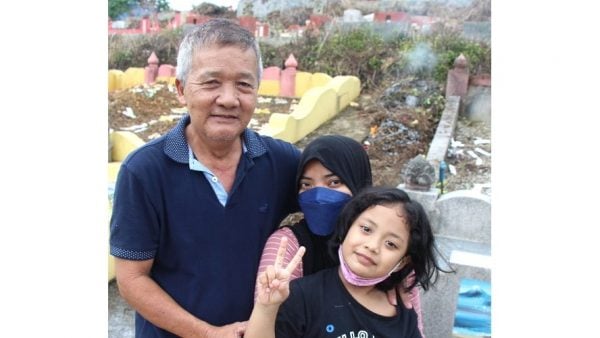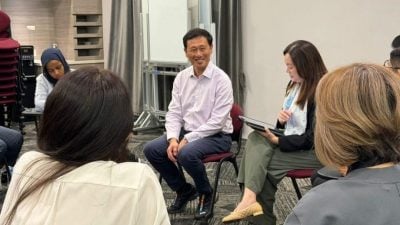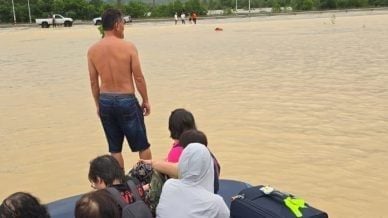To visit the tombs of the city’s pioneers Yap Ah Loy, Chew Yok and Chan Sow Lin, we drove to the other end of the Association of Kwong Tong Cemetery Management KL.
As soon as we got down from our vehicle, and asked Pek Wee Chuen about how the Chan Sow Lin curry fish head came about, he said laughingly, “This has become a joke in the academic circle because many people don’t even know that Chan Sow Lin had nothing to do with the person first starting the famous curry fish head recipe.”
The cemetery covers a total land area of 260 acres. Besides early Chinese migrants, it is also the final resting place for some 19 of the city’s early Chinese community leaders — people from Yap Ah Loy, the city’s founder, to Chan She Shu Yuen’s founder Chan Sow Lin, and Chew Yok known for his remarkable contribution to the nation’s railway history — were all buried here.
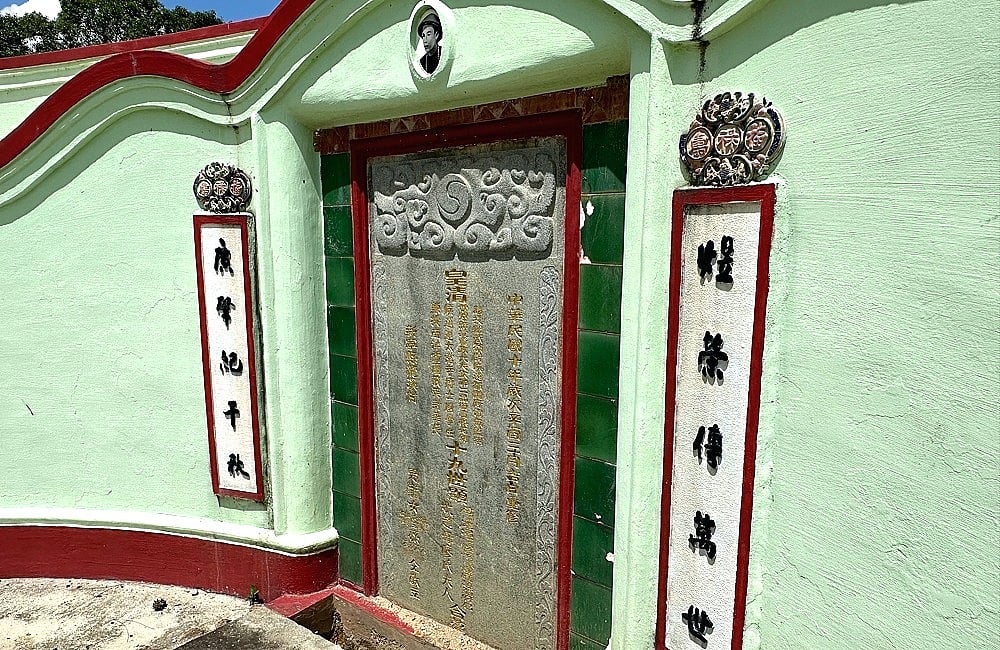
Chew Yok (1843-1892)
“Well, let’s first take a look at Chew Yok’s tomb.
“From the fully encircling layout of the tomb, it is not hard to tell that this is very typical Cantonese tomb design.”
Chew’s final resting place looks rather eye-catching in the midst of other humbler ones around it.
Unlike the other lime-colored tombs, it was painted bright green on the outside.
Pek, who has been studying traditional Chinese cemeteries for many years, explained, “It was in the mid-1910s, and this tomb is almost as tall as me, showing that the person buried here must be a real somebody!”
Chew was born in 1843 in Taishan in China’s Guangdong province.
He was a famous tin miner and businessman, and had contributed remarkably to the building of the first rail line between Kuala Lumpur and Klang.
He came to Southeast Asia at the age of 17, stopping first in Penang to work as a laborer before going to Taiping to work as a tin miner.
He found a site rich in tin deposits in Klang at the age of 19, and enlisted the help of some migrants hailing from his own ancestral village to start the Ghee Hin Kongsi to engage in mining activities.
His tin mine was subsequently destroyed during the 1867 Selangor civil war.
Yap Ah Loy had very high regards for Chew’s exceptional ability and diligence, and invited him to join and take up a key role in the Selangor civil war and assist him in quelling the rebellion. 1
They later became in-laws and by that time, Chew was already one of the biggest mine owners in Selangor.
In 1853, the Selangor government was actively developing the area’s transport. However, the progress had been limited as a result of acute labor shortage.
Chew unhesitantly mobilized some 300 workers from his tin mine to help expedite the construction of the railways from Kuala Lumpur to Klang and Ampang.
In view of that, there was this saying among the local residents that while Yap Ah Loy helped build the roads for bull carts, Chew Yok was instrumental in the development of local rail transport.
In 1886, Chew and his friends proposed to set up the Kwong Siew Association. Chew even donated generously in land and cash for the construction of the association building for the well-being of the Kwong Siew people working in Kuala Lumpur.
To commemorate his outstanding contributions towards the local Chinese community, there was even a road named after him in KL, but was later renamed Lorong Titiwangsa 2.
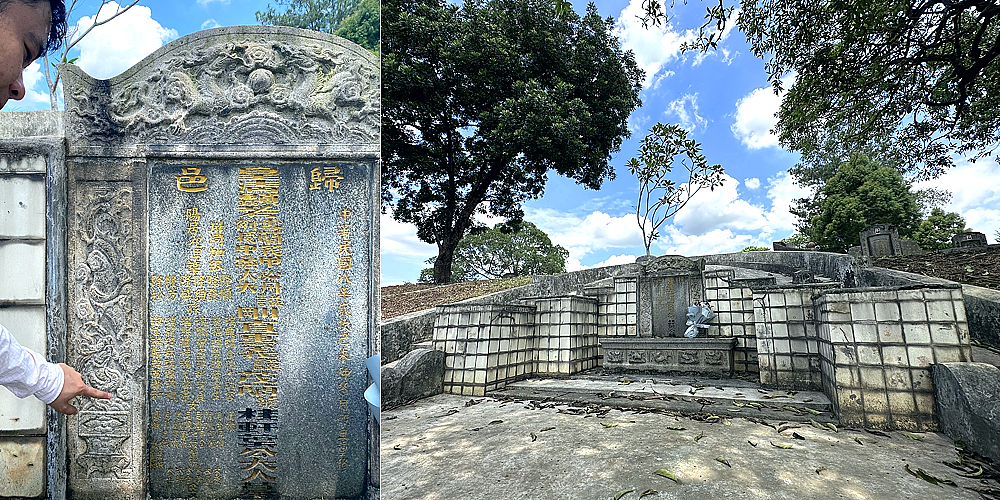
Yap Ah Loy (1837-1885)
From the stories about Chew Yok, it is not hard to deduce that Yap Ah Loy was commanding a very lofty social status in KL during the early years in the city’s history.
After leaving Chew Yok’s tomb, we made our way forward and soon came to a sign marked “Kapitan Yap Ah Loy’s tomb.” Walking further down, we finally came to the city founder’s final resting place.
“This one is his tomb, although you won’t see his name here,” Pek explained.
In its stead, it was marked as the tomb of a “Yap Mao Lan,” which was actually the original name of Yap Ah Loy.
Pek explained that during the early days, Chinese migrants came down to Malaya mainly on three different routes.
“Basically, these were Melaka, Negeri Sembilan to Selangor; Singapore, Johor to Melaka; and Penang, Perak to the northern states.
“Yap Ah Loy was taking the first route.”
Born to a rural farming family in Huiyang county in China’s Guangdong province, Yap Ah Loy came down from China in a boat at the age of 17 in 1854.
After two months of rough sea journey, he arrived in Melaka, where most of the Yaps lived during those years.
Unfortunately, as he got addicted to gambling, he lost all his money for the return trip home. As a result, he had to walk all the way from Melaka to Lukut and became a cook at the tin mine there.
During those three years, Yap managed to quit the gambling habit and save up some money. At the same time, he had also learned to run a tin mine while working there.
This paved the way for him to later venture into pig farming and tin ore businesses.
In 1859, Liu Ngim Kong, then Kapitan Cina of Kuala Lumpur, invited Yap to help develop the area. He was embroiled in the 1866 Selangor civil war, and helped Selangor Sultan Tengku Kudin quell the rebellion.
Three years later, Yap was appointed Kuala Lumpur’s third Kapitan Cina, and was authorized to fully develop Kuala Lumpur.
Between 1873 and 1880 after the civil war, he purchased mining equipment from the colonial government.
The Industrial Revolution in Europe had sent tin prices skyrocketing, making Kuala Lumpur the most important economic hub of Peninsular Malaya.
In addition, Yap Ah Loy also improved on local transportation, including building major thoroughfares inside the downtown core area such as Jalan Pasar, Old Market Square, Petaling Street and Pudu Street.
“Between these two posts is the massive area of the Yap family graveyard, and this shows that people buried here must be of certain stature in the local Chinese society.”
Pek continued, “Later KL developed into a major economic hub, luring people from the north to seek a better living here, including Chan Sow Lin.”
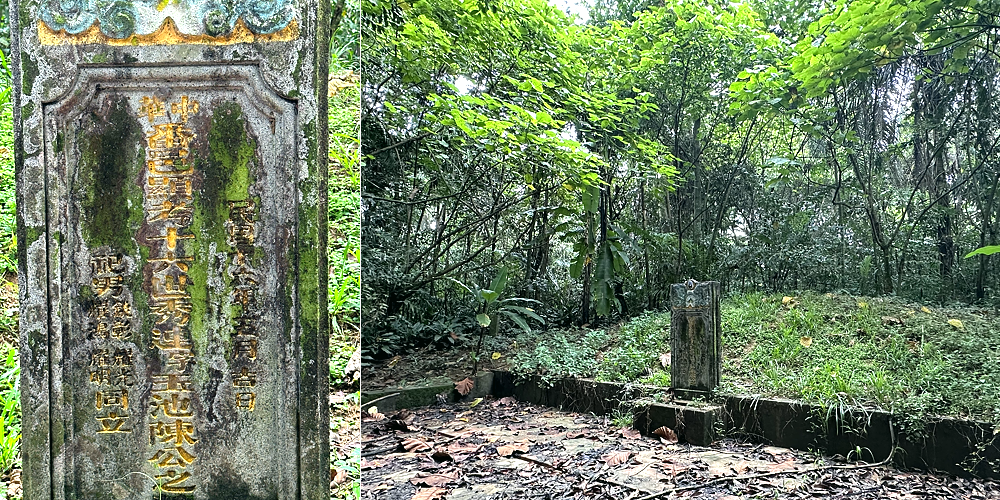
Chan Sow Lin (1845-1927)
Moving over to the other side of the cemetery, the tomb of this renowned philanthropist and entrepreneur is very conspicuous, just like those of other departed local dignitaries.
Pek led us to Chan’s final resting place purely by way of memory.
“As his tomb is quite far off from the main center of activity, it is hard to locate and not many will actually come to this part of the cemetery.”
With the consent of the owner of the burial ground, we headed to Chan Sow Lin’s tomb.
As mentioned earlier, all that younger Malaysians know about Chan Sow Lin is just curry fish head and not much else.
But, why was Chan Sow Lin in any way associated with this favorite Malaysian food?
Pek explained, just because there was this famous fish head shop along this road called Jalan Chan Sow Lin, Chan was erroneously called Klang Valley’s “king of curry fish head.”
He was born in an impoverished family in Panyu, Guangdong. He came to Malaya for a better living in 1861 at the age of 16, and came to know Loke Yew while working at a tin mine in Perak.2
He later followed Loke Yew to Kuala Lumpur, where he first set up a tin mining company in Serdang. Unfortunately, the company closed down due to poor business.
Thanks to recommendation from Loke Yew to bring in modern mining equipment, he later managed to grow his mining business.
After that, he opened Klang Valley’s first Chinese foundry business Mei Lee on Jalan Ampang, and this helped catalyze the local economy.
The scale of the factory had expanded to such a way that he could afford to hire technicians from Europe, Guangzhou and Hong Kong to come here to train the local workers.
Many foundries were subsequently set up in the vicinity following Mei Lee’s success.
Back then the colonial government set aside a plot of land near the old Sungai Besi airport as a steel manufacturing hub, and the major road there was subsequently named Jalan Chan Sow Lin.
Chan not only had contributed significantly to the local economy, he even teamed up with some friends to establish the Chan Clan Temple (Chan She Shu Yuen) in 1897, on a plot of land on which seven shophouses he donated used to sit, at the end of Petaling Street.
Additionally, he also built Tung Shin Hospital, Chik Shin Tong Kuala Lumpur, Confucian Private Secondary School and Victoria Institution.
This is the last of three articles in the series of Chinese cemeteries and the traditional tomb-sweeping festival.
- The final resting place for early Chinese migrant workers
- Tombstone inscriptions: telling the stories of the departed
- A pilgrimage to the tombs of the city’s pioneers
Notes:
- Between 1867 and 1874, a series of conflicts erupted within Selangor, causing not only political and economic commotion but also giving the British an excuse to intervene in the administration of Selangor.
- Loke Yew was widely known as the “king of tin mining” in Kuala Lumpur, and was also known for his dedication in promoting the local education, having donated for schools and colleges not only in Malaya but also overseas, including Hong Kong University where the main hall was named after him and where his bronze statue still stands today.
ADVERTISEMENT
ADVERTISEMENT






